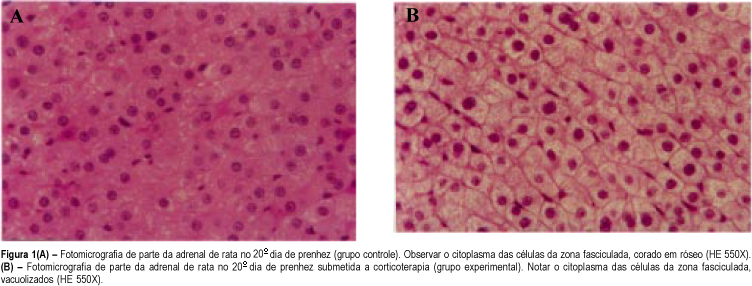Summary
Revista Brasileira de Ginecologia e Obstetrícia. 2002;24(10):663-668
DOI 10.1590/S0100-72032002001000005
PURPOSE: to evaluate the effect of intravascular transfusion on ductus venosus and inferior vena cava Doppler ultrasound indexes (SV/CA) and to relate it to hemoglobin levels before transfusion. METHODS: this is a transversal prospective study. A total of 62 intravascular transfusions were performed in 27 fetuses from pregnancies with red blood cell isoimmunization. The 62 cases were divided into two groups: (1) fetuses with hemoglobin levels before transfusion £10 g/dL and (2) fetuses with hemoglobin levels before transfusion >10 g/dL. The SV/CA and CA/SV indexes were measured using color Doppler ultrasound 6 h before and 12 h after intravascular transfusion. The index values before and after transfusion in all 62 cases were compared. Thereafter we compared these indexes before and after transfusion regarding each group. The Wilcoxon test was used and the results were considered statiscally significant when p<0.05. RESULTS: when we studied the whole group (62 cases) no significant difference was observed between the CA/SV index before and after transfusion (p=0.775). On the other hand, a significant increase in the SV/CA index was observed after transfusion (p=0.004). No significant differences were observed in both the SV/CA and CA/SV indexes before and after transfusion in the group of fetuses with hemoglobin levels before transfusion £10 g/dL (p=0.061 and p=0.345, respectively). There was a significant increase in the CA/SV index after transfusion in fetuses with hemoglobin levels before transfusion >10 g/dL (p=0.049), but the SV/CA index did not change in this group (p=0.086). CONCLUSION: venous Doppler study may be useful to understand fetal hemodynamic adjustment after intravascular transfusion. An increase in SV/CA without change in CA/SV after transfusion in anemic fetuses may be an important compensatory mechanism to increase intravascular volume. The increase in CA/SV index in fetuses with hemoglobin levels before transfusion <10 g/dL suggests a state of fetal hypervolemia.
Summary
Revista Brasileira de Ginecologia e Obstetrícia. 2004;26(8):663-667
DOI 10.1590/S0100-72032004000800011
Macroprolactinomas are benign prolactin-secreting pituitary tumors, causing amenorrhea, galactorrhea and gonadal dysfunction. Clinical treatment with dopamine agonists is the first-choice therapy. Surgery is indicated for the rare cases that are resistant to clinical treatment, when there is intolerance to the medication, or intratumoral hemorrhage is detected. We describe the case of a female patient with macroprolactinoma submitted to two surgical procedures and resistant to clinical treatment, with unusual evolution.
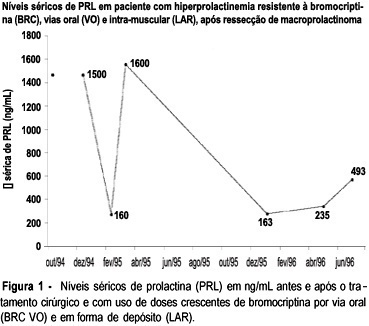
Summary
Revista Brasileira de Ginecologia e Obstetrícia. 2018;40(11):664-672
To compare two different treatments—the use of highly purified anhydrous (HPA) lanolin and expressed breast milk—for women with pain and nipple trauma during the breastfeeding process.
A total of 180 puerperal women were randomly assigned to 2 groups: one was treated with HPA lanolin and the other with their own expressed breast milk. All of the participants received the same breastfeeding technique instructions and therapeutic care standard. Three assessments were performed: at the time of inclusion in the study (after randomization); after 48 hours; and after 7 days. At each interval, data was collected in relation to pain and trauma. A numerical/verbal category scale was used for the pain variable, and the nipple trauma score for the trauma variable. The results were subjected to statistical analysis using the chi-squared test, the Fisher exact test, the student t-test, and the Kolmogorov-Smirnov test. Generalized estimating equations were calculated using the STATA 12 statistical software package (StataCorp LLC, College Station, TX, USA) and IBM SPSS Statistics for Windows, Version 20.0 (IBM Corp, Armonk, NY, USA).
There was pain improvement from the second to the third assessment in the group that used HPA lanolin, while the pain remained unchanged between these two periods (p< 0.001) in the breast milk group. In terms of trauma, improvement was identified in its extension and depth from the first to the third assessment, and it was higher in the HPA lanolin group than in the breast milk group (p= 0.025).
The treatment of pain and nipple trauma with HPA lanolin achieved better results than the one with breast milk, based on a 7-day treatment period.
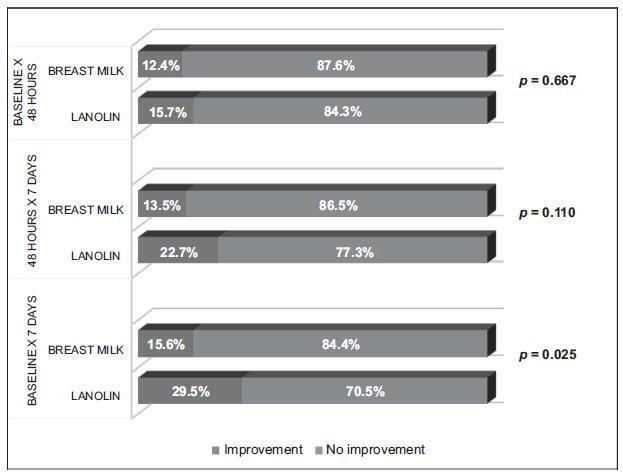
Summary
Revista Brasileira de Ginecologia e Obstetrícia. 2006;28(11):664-670
DOI 10.1590/S0100-72032006001100006
PURPOSE: to assess the role of ultrasonographic cervical length in predicting premature labor in patients presenting persistent uterine contractions and intact membranes. METHODS: a prospective observational cohort study was performed in 45 women admitted to our hospital between 22 and 34 weeks of gestation. Transvaginal sonographic evaluation of the cervix was performed once in the women who had completed a course of parenteral tocolysis. The cervical length was obtained according to criteria reported previously. Cervical sonographic findings were not used in diagnosis and management. Outcome variable was the occurrence of preterm delivery (<37 weeks). Statistical analysis consisted of univariate method with the purpose of determining the significant contribution of cervical length to the prediction of preterm delivery. The adopted significance level was 5% (p<0,05) and the confidence interval was 95% (95% CI). RESULTS: the incidence of preterm delivery was 51.11% (23/45). Cervical length was significantly associated with the outcome (p<0.0001). Receiver operating characteristic curve analysis showed that a cervical length of 20 mm was the best cutoff in predicting preterm delivery (sensitivity 86.9%; specificity 81.8%; positive predictive value 83.3%; negative predictive value 85.7%). The calculated area under the curve was 0.91 (95% CI: 0.79-0.97; p<0.0001). CONCLUSIONS: among women with persistent uterine contractions and intact membranes treated for preterm labor, a cervical length of less than 20 mm demonstrated a high likelihood of preterm birth. Transvaginal ultrasound may improve the accuracy of diagnosis in symptomatic women.
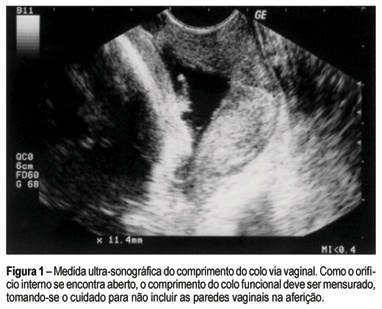
Summary
Revista Brasileira de Ginecologia e Obstetrícia. 2005;27(11):665-671
DOI 10.1590/S0100-72032005001100006
PURPOSE: to define the characteristics of unviable embryos that may be donated for stem-cell research. METHODS: a retrospective evaluation of in vitro fertilzation cycles between January 1995 and January 2005 was structured. Cycles were chosen in which the embryos transferred to the uterine cavity had the same morphological characteristics. Subsequently, the rates of pregnancy, implantation, and involution of the gestational sacs of the fresh embryos as well as of those cryopreserved were analyzed and distributed into groups according to their morphology. Embryos that were symmetric and with 0% of fragmentation were designated type A; asymmetric with up to 25% of fragmentation were designated type B; between 25 and 50% of volume occupied were designated type C, and those with 50% or more of fragmentation were designated type D. RESULTS: one hundred and seventy-two type D embryos transferred in 87 cycles presented low rates of implantation (11%) with 50% of those implanted persisting in development. Embryos with the same morphology, after cryopreservation and thawing, did not show the capacity to evolve. In 36 cycles, 113 thawed type D embryos were transferred, resulting in only one implantation, presenting a minute 3% pregnancy rate. The implanted gestational sac did not evolve, showing a 100% rate of involution. CONCLUSION: embryos with low morphological scores cannot be considered unviable because they are capable, even though with a very low frequency, of supporting gestation. However, these same embryos, after cryopreservation, thawing and transfer showed an insignificant rate of pregnancy, that did not result in viable pregnancy. Therefore, when in excess to requirements, type D embryos should not be cryopreserved; instead, rather than discarded, they should be donated for embryo stem-cell research.
Summary
Revista Brasileira de Ginecologia e Obstetrícia. 2022;44(7):667-677
To compare the sexual violence suffered by women in early and late adolescence, the reactions triggered after the aggression, and the care provided.
A retrospective study in which we reviewed the medical records of 521 female adolescents treated by a multidisciplinary team at a reference hospital in the city of Campinas, state of São Paulo, Brazil. We analyzed sociodemographic variables, and those pertainin to the characteristics of the episodes of violence, the emergency care, and the physical and psychological reactions observed during the follow-up. For the analysis, the sample was divided into groups of early (10 to 14 years) and late (15 to 18 years) adolescence. We used the Chi-squared/Fisher Exact, Mann-Whitney, and Kruskal-Wallis tests to compare the groups; the level of significance adopted was 5%.
The early group (n= 242) contained more adolescents who were enrolled in school (p< 0.001), suffered more daytime aggressions (p= 0.031), in their residences (p< 0.001), by an aggressor with whom they were acquainted (p< 0.001), had greater need of legal protection (p= 0.001), and took longer to seek care (p= 0.048). Feelings of guilt, shame, and the perception of violence were similar between the groups. In the late group (n= 279), there was greater consumption of alcohol during the aggression (p= 0,005); they received significantly more prophylaxis treatments; reported more physical symptoms (p= 0.033), sleep disorders (p= 0.003), symptoms of anxiety (p= 0.045), and feelings of anguish (p= 0.011); and had more prescriptions of psychotropics (p= 0.005). Only 52% completed the 6-month follow-up, with no differences between the groups.
The age groups showed differences in the characteristics of the episodes of violence; early adolescents took longer to seek help, and the late group presented more intense symptoms and psychological worsening during the follow-up. Measures of prevention and specific care aimed at this population are needed.
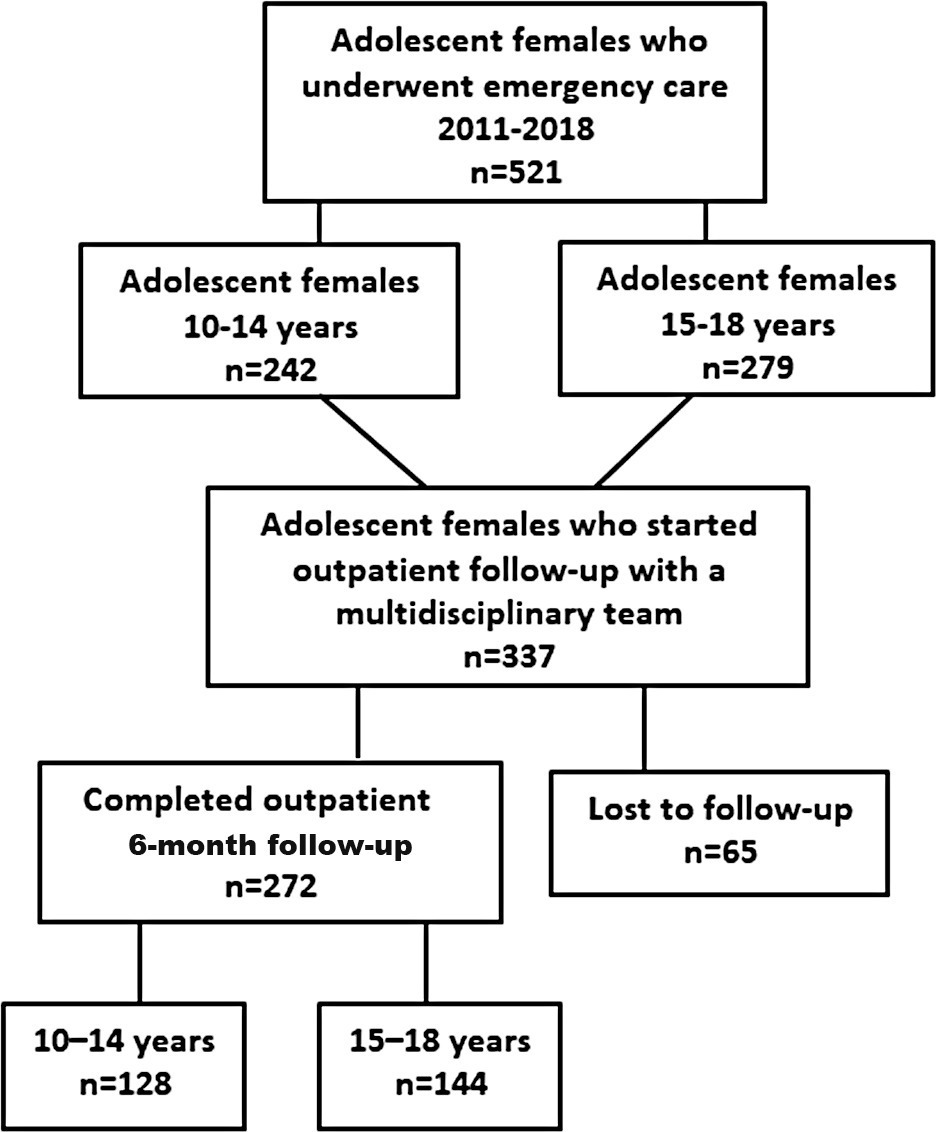
Summary
Revista Brasileira de Ginecologia e Obstetrícia. 2003;25(9):667-672
DOI 10.1590/S0100-72032003000900008
PURPOSE: to compare the results of hysterosonography with those of hysteroscopy and the histopathologic study in postmenopausal women. METHODS: hysterosonography, hysteroscopy and endometrial biopsy were performed in 59 women who had an endometrial echo over 4 mm, age above 40 years and amenorrhea over one year, and whose follicle-stimulating hormone levels were over 35 mIU/mL. Patients using hormones were excluded, as well those in whom it was impossible to perform histerosonography, histeroscopy or endometrial biopsy. The statistical analysis was performed using the nonparametric "G"-Cochran and McNemar tests. In addition, sensitivity and specificity, as well as positive and negative predictive values were determined. The value of 0.05 or 5% for rejection level of the null hypothesis was applied. RESULTS: the agreement rates of hysterosonographic results compared to hysteroscopy and histopatology were 94.8 ande 77.6%, respectively. Sensitivity and specificity of hysterosonographic evaluation of the abnormal endometrial cavity were 98 and 75%, respectively, when compared to hysteroscopy. In addittion, positive and negative predictive values of hysterosonography were 96 and 86%, respectively. When the histopathologic study was used as the gold standard, sensitivity and specificity were 98 and 33%, with positive predictive value of 76% and negative predictive value of 86%, for the detection of the endometrial cavitary changes. One great concern were the histopathologic results of two patients with uterine synechia who showed endometrial hyperplasia. Also, one patient was diagnosed as normal using histerosonography and the histopatological result showed simple hyperplasia. CONCLUSIONS: our data suggest that hysterosonography presented good sensitivity as compared with hysteroscopy. However, uterine synechia is the great limitation of this method as compared with histopathology.
Summary
Revista Brasileira de Ginecologia e Obstetrícia. 2001;23(10):667-673
DOI 10.1590/S0100-72032001001000009
Purpose: the repetitive use of antenatal corticosteroid therapy for acceleration of fetal lung maturation has been common in cases at risk of preterm delivery. We studied the corticosterone levels at term and the morphologic aspects in the maternal and fetal adrenal glands submitted to the effect of betamethasone in the second half of rat pregnancy in order to verify its consequences. Methods: thirty female pregnant rats were divided into three groups of ten animals each. Group I received betamethasone on the 11th, 12th, 18th and 19th day of pregnancy. Group II received distilled water on the same days (control group). Group III did not receive any drug (stress control group). All rats were sacrificed on the 20th day of pregnancy when plasma corticosterone levels of dams were assessed and the maternal and fetal adrenal glands were studied by light microscopy. Results: plasma corticosterone level of dams was lower in the group treated with betamethasone (4.8 mg/dL) when compared with the control groups (17.7 and 26.8 mg/dL). The light microscopy study revealed cytoplasmatic vacuolation in the fasciculate zone in the maternal and fetal adrenal glands, which indicates adrenal suppression. Conclusions: the antenatal repetitive and prolonged use of corticosteroids in pregnant rats for acceleration of lung fetal maturation causes maternal and fetal adrenal suppression.
